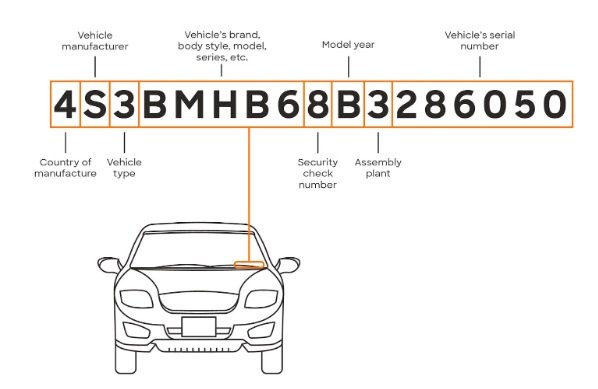
By | John Preston
The VIN is the key to discovering a vehicle’s history. The 17-character VIN that’s stamped on your car may seem like a jumble of numbers and letters, but it contains a lot of information about a car’s past and present.
Let’s take a closer look at what the characters in a VIN mean, where you can find a car’s VIN, and when it can be useful.
What does the VIN mean?
Each VIN is unique – think of it like a car’s fingerprint. All cars in the United States with a year of manufacture of 1981 or later must have a VIN in the same standardized format. Vehicles built before 1981 had VINs, but their length and format varied by automaker.
Although the string of numbers and letters may appear to be randomly assigned, there is actually a code, in which the characters are translated into different types of information about the vehicle.
- Characters 1-3 identify the manufacturer of the cart.
- Characters 4-8 describe the vehicle model, body style, engine type, and other data.
- Character 9 is a code filled in by the manufacturer to confirm the accuracy of the VIN.
- The character 10 indicates the model year of the vehicle.
- Character 11 reveals the vehicle’s assembly plant.
- Characters 12-17 are the serial number of the car (for high volume manufacturers).
If you want to understand what a car’s VIN means, the National Highway Traffic Safety Administration’s (NHTSA) VIN Decoder can help. When you enter the car’s VIN and model year, the VIN Decoder tool will interpret the VIN for you.
Where can I find the VIN of a car?
The VIN can appear in one or more places on a car, as well as on some documents.
In the car
The most common location is where the windshield meets the instrument panel on the driver’s side of the vehicle. To see it easily, stand outside the car. The driver’s side door frame, near the door latch, is another place to look.
Under the Federal Motor Vehicle Theft Prevention Rule, vehicles with a model year of 1987 or later that are designated as “high risk of theft” also display the VIN on certain major parts such as the engine, transmission, doors and fenders. This can help police track down and recover stolen car parts.
Pay attention to the VIN of a vehicle you are considering buying. If the VIN appears in multiple places, but the number and letter combination is not the same in each place, the car may have been rebuilt with stolen parts.
in some documents
If you are not near the car, you can also probably find the VIN on the car’s title or registration card, car insurance policy, or service records.
Why is the VIN important?
A VIN comes into play in several scenarios.
If you want to buy a used car
When buying a used car, knowing the details of the car’s history can help you make sure you don’t end up buying “a lemon”. Dealers and car buying websites can provide vehicle history reports, but if you buy the car from an individual, you may need to obtain a report on the car yourself.
For that, you will normally need the VIN of the car. You can easily access vehicle history reports on various websites, such as Carfax and AutoCheck, using the VIN.
You can also use the National Insurance Crime Bureau’s VINCheck tool to find out if a car has been reported stolen or has a salvage title.
If you want to know if the car has any recall announcements
Are you curious to know if the manufacturer of your car has issued any recall announcements involving your car, or if a car you are thinking of buying has made a significant car recall announcement? Enter the VIN into the National Highway Traffic Safety Administration’s (NHTSA) recall tool to stay up-to-date on car-specific recalls in the last 15 calendar years.
If your car is stolen
It’s a good idea to have the VIN on hand in case your car, or parts of it, is stolen. Police can enter the VIN into their local and national databases and can use it to help identify and recover a stolen vehicle or parts.
Next steps
The VIN can reveal a lot of essential information about a vehicle. If you plan to buy a used car, use the VIN to gather information about the vehicle’s past.
But don’t settle for the vehicle history report. Be sure to test drive and have your vehicle inspected by an independent mechanic who can advise you on the reliability of the car before you buy it.






